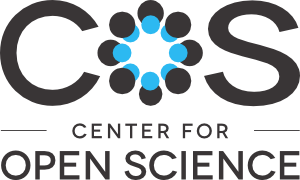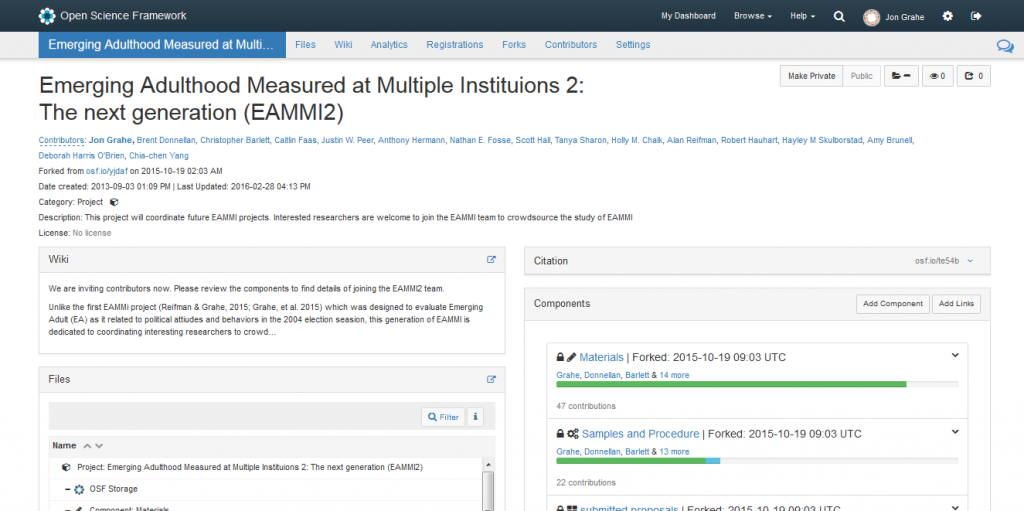The Open Science Framework Changed my Workflow (for the better!)
by Jon Grahe, Professor of Psychology at PLU
It never occurred to me that I needed the Open Science Framework (OSF). It was shared with me because the developers knew that I was interested in trying to create large scale collaborative research projects, and so I ended up on their email list. The Center for Open Science developed the OSF (free to all users) to provide researchers with the capacity to engage in scientific transparency. You might have noticed the furor around the Reproducibility Project or perhaps the slowly emerging consideration of the more impressive Transparency of Publication guidelines.
However, I wasn’t involved in those activities, and that isn’t why I’m suggesting you consider using the OSF in your own scholarly and teaching workflow. While addressing an audience for a Psi Chi Distinguished Lecture at Western Psychological Association in 2012, Brian Nosek (cofounder of the COS) explained the value of the OSF by sharing a story about a collaborator emailing him and asking for a project file. He recalled the struggle of tracking the file on lab and personal computer to another collaborator’s computer. This story is one that any researcher might recall from his or her own past. Whether that file was ever found or not, the internet allows us to avoid losing files on hard drives. The OSF provides the capacity to keep those files in one place so that all collaborators (or any interested reader as the owner allows) can access them for future use.
Think of the OSF as an online, electronic file cabinet with the potential to serve as an interactive website. This cabinet can hold folders with other folders inside of those folders. I have no idea how many layers of folders are possible, but each folder can be kept private or shared as desired. Within each folder, files can be “dragged and dropped” from computer to the OSF location. Collaborators or visitors can download those files following the owner-allowed permissions. Documents and spreadsheets, pictures and video (or links to large video): files galore at your disposal. In the 2 ½ years I have been exposed to the OSF, I have come to rely on this electronic file cabinet/interactive website for most of my research projects and I have increasingly introduced it into the classroom.
 The OSF allows me to collaborate easily with researchers at different institutions. Each of us can edit, upload, and create asynchronously. These folders (which are called components on the OSF) can be connected to other online applications (i.e., Google Drive, Dropbox, Github). When I make a new file and put it in a certain Dropbox folder, that file automatically gets saved on all my Dropbox computers as well as on my OSF project. My primary research activity encouraging undergraduates to coordinate their research activity could not be possible without the OSF. In addition, my local collaborations also benefit from using the OSF as our shared workspace.
The OSF allows me to collaborate easily with researchers at different institutions. Each of us can edit, upload, and create asynchronously. These folders (which are called components on the OSF) can be connected to other online applications (i.e., Google Drive, Dropbox, Github). When I make a new file and put it in a certain Dropbox folder, that file automatically gets saved on all my Dropbox computers as well as on my OSF project. My primary research activity encouraging undergraduates to coordinate their research activity could not be possible without the OSF. In addition, my local collaborations also benefit from using the OSF as our shared workspace.
In the classroom, the OSF provides a platform for students to share their work easily and privately with their partner; they can also include the instructor or the public. The OSF is not limited to psychology, or sciences. My 16-year-old daughter is using the OSF to conduct her own independent art study by uploading a weekly activity and seeking feedback from mentors. She can even share her artwork with her grandparents just for their own enjoyment.
While the OSF should not replace other online resources, it is quite easy to integrate them with it. I am shocked at how much the OSF has influenced my workflow. I invite you to try it as well.


